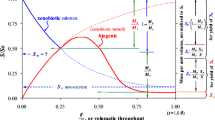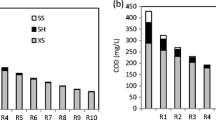Abstract
The two-tank accelerator/aerator modification of activated sludge significantly increases the biodegradation of hydrocarbons requiring initial monooxygenation reactions, such as phenol and 2,4-dichlorophenol (DCP). The small accelerator tank has a controlled low dissolved oxygen (DO) concentration that can enrich the biomass in NADH + H+. It also has a very high specific growth rate (μ acc) that up-regulates the biomass’s content of the monooxygenase enzyme. Here, we develop and test the ACCEL model, which quantifies all key phenomena taking place when the accelerator/aerator system is used to enhance biodegradation of hydrocarbons requiring initial monooxygenations. Monooxygenation kinetics follow a multiplicative relationship in which the organic substrates (phenol or DCP) and DO have separate Monod terms, while the biomass’s content of NADH + H+ has a first-order term. The monooxygenase enzyme has different affinities (K values) for phenol and DCP. The biomass’s NADH + H+ content is based on a proportioning of NAD(H) according to the relative rates of NADH + H+ sources and sinks. Biomass synthesis occurs simultaneously through utilization of acetate, phenol, and DCP, but each has its own true yield. The ACCEL model accurately simulates all trends for one-tank and two-tank experiments in which acetate, phenol, and DCP are biodegraded together. In particular, DCP removal is affected most by DOacc and the retention-time ratio, Θacc/Θtotal. Adding an accelerator tank dramatically increases DCP removal, and the best DCP removal occurs for 0.2 < DOacc < 0.5 mg/l and 0.08 < Θacc/Θtotal < 0.2. The rates of phenol and DCP utilization follow the multiplicative relationship with a maximum specific rate coefficient proportional to μacc. Finally, μ acc increases rapidly for Θacc/Θtotal < 0.25, acetate removal in the accelerator fuels the high μ acc, and the biomass’s NADH + H+ content increases very dramatically for DOacc < 0.25 mg/l.
Similar content being viewed by others
References
TB Bahder (1995) Mathematica for Scientists and Engineers Addison-Wesley Publishing Co., Inc. New York
Dahlen, EP, 1999. Accelerating Detoxification by Manipulating Intracellular Electron Carriers, Ph.D. dissertation, Dept. of Civil Engineering, Northwestern University, Evanston, IL, USA
E. P. Dahlen B. E. Rittmann (2000) ArticleTitleAnalysis of oxygenation reactions in a multi-substrate system – a new approach for estimating substrate-specific true yields Biotechnol. Bioeng. 70 685–692 Occurrence Handle1:CAS:528:DC%2BD3cXoslajtLY%3D Occurrence Handle10.1002/1097-0290(20001220)70:6<685::AID-BIT11>3.0.CO;2-#
E. P. Dahlen B. E. Rittmann (2002a) ArticleTitleTwo-tank suspended growth process for accelerating the detoxification kinetics of hydrocarbons requiring initial monooxygenation reaction Biodegradation 13 101–116 Occurrence Handle1:CAS:528:DC%2BD38XnsVKktLc%3D Occurrence Handle10.1023/A:1020461225393
EP Dahlen BE Rittmann (2002b) ArticleTitleA detailed analysis of the mechanisms controlling the acceleration of 2.4-DCP monooxygenation in the two-tank suspended growth process Biodegradation 13 117–130 Occurrence Handle1:CAS:528:DC%2BD38XnsVKktLY%3D Occurrence Handle10.1023/A:1020498305731
G. Gottschalk (1986) Bacterial Metabolism EditionNumber2 Springer-Verlag, Inc. New York
CPL Grady SuffixJr. GT Daigger HC Lim (1999) Biological Wastewater Treatment EditionNumber2 Marcel Dekker, Inc. New York
E Kreyszig (1993) Advanced Engineering Mathematics EditionNumber7 John Wiley and Sons, Inc. New York
SG Pavlostathis E Giraldo-Gomez (1991) ArticleTitleKinetics of anaerobic treatment: A Critical Review Crit. Rev. Env. Contr. 21 IssueID5/6 411–490 Occurrence Handle1:CAS:528:DyaK38XhvVShtbc%3D Occurrence Handle10.1080/10643389109388424
LR Petzold (1983) ArticleTitleAutomatic selection of methods for solving stiff and nonstiff systems of ordinary differential equations SIAM J. Sci. Stat. Comp. 4 136–148 Occurrence Handle10.1137/0904010
BE Rittmann PL McCarty (2001) Environmental Biotechnology: Principles and Applications McGraw-Hill Book Co. New York
BE Rittmann E Seagren BA Wrenn AJ Valocchi C Ray L Raskin (1994) In Situ Bioremediation EditionNumber2 Noyes Publishers, Inc. Park Ridge, NJ, USA
PB Sáez BE Rittmann (1993) ArticleTitleBiodegradation kinetics of a mixture containing a primary substrate (phenol) and an inhibitory co-metabolite (4-chlorophenol) Biodegradation 4 3–21 Occurrence Handle10.1007/BF00701451
S Wolfram (1994) Mathematica, the Student Book Addison-Wesley Publishing Co., Inc. New York
Author information
Authors and Affiliations
Corresponding author
Rights and permissions
About this article
Cite this article
Dahlen, E.P., Rittmann, B.E. The ACCEL Model for Accelerating the Detoxification Kinetics of Hydrocarbons Requiring Initial Monooxygenation Reactions. Biodegradation 17, 237–250 (2006). https://doi.org/10.1007/s10532-005-5019-8
Accepted:
Issue Date:
DOI: https://doi.org/10.1007/s10532-005-5019-8




